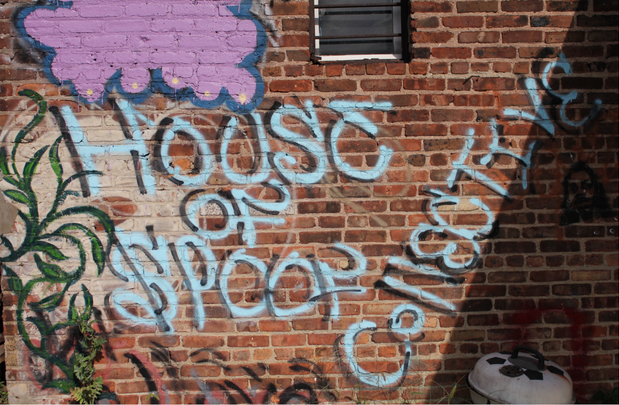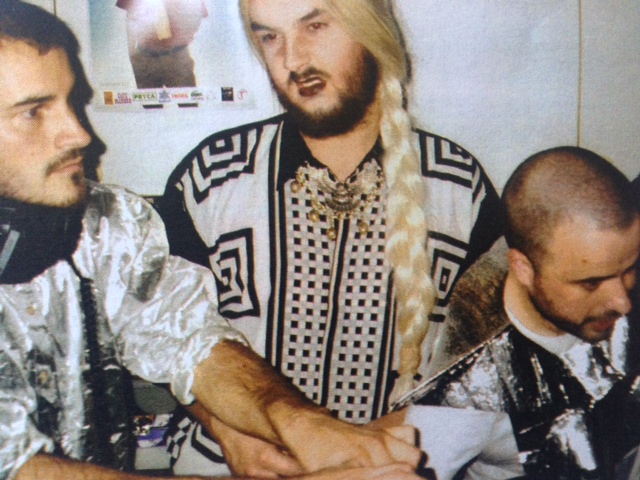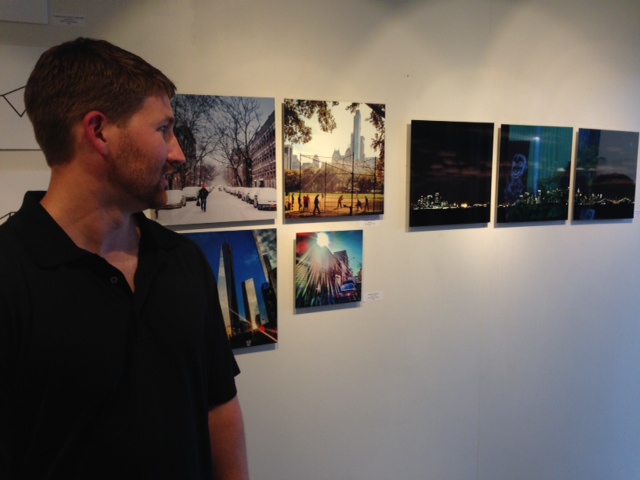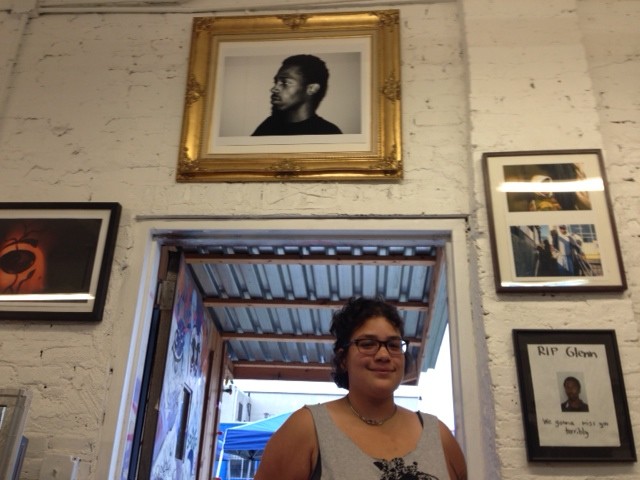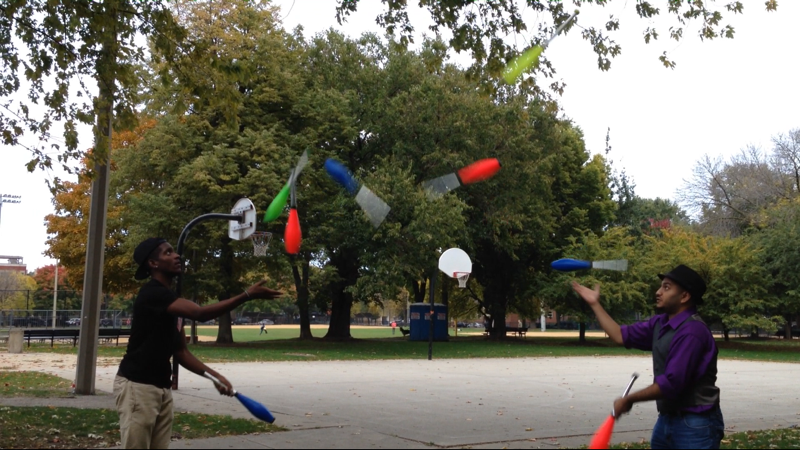
Jean-Tae Francis (left) learned a bit of everything the circus has to offer before he specialized in juggling. (Amy Chen / THE POINT)
On a cool Tuesday evening in September, the empty lobby of Hunts Point’s community center filled with the whooshing sounds of colored balls flying through the air as instructor Jean-Tae Francis led a game of “100-ball juggling” with his group of aspiring circus performers.
Nineteen-year-old Francis stood in the middle, encircled by about 10 teenage circus students, began the game by juggling three red-colored balls. He called on his students one by one, to toss their juggling balls in his direction. The goal was to continue a three-ball juggling pattern amidst the flurry of incoming balls. Following Francis’ demonstration, each of the students took turns at the center, their high-pitched laughter echoing throughout the The Point Community Development Corporation.
In the auditorium next door, another dozen or so students practiced a series of rigorous cartwheels, somersaults and other potentially dangerous tumbling moves, a staple in professional circus acts. This circus program – the only one in the Bronx – is run for free two nights a week by Cirque du Monde, a social outreach program created by Cirque du Soleil. Each class has an average attendance of about 15 to 20 students, some of whom attend both sessions two nights a week throughout the academic year. According to Cirque du Monde’s website, the program combines “circus techniques together with educational social intervention to help young people.” But for some students, the circus is more than a temporary, after-school activity. It is a possible career choice.
Francis wandered into the Hunts Point circus class four years ago simply looking for something to occupy his time. “I came here to learn a few tricks, like how to do a flip or two, and continue with my life,” said Francis, as he looked around the lobby of The Point, which has now become almost like a second home to him. But, he said, he was slowly drawn into the world of circus not only as a social outlet, but also as a possible way of life.
The jovial teenager, with a small, permanent smile on his face, immigrated to the United States when he was 14 years old from Antigua and moved in with his aunt in New Jersey. “There weren’t many Caribbean people around so it was hard for me to make friends,” said Francis about his time in New Jersey. A year later, he moved to the Bronx, where the circus became his main social activity. “Most of my friends now are from the circus.” He settled in school and absorbed the culture shock as, he said, school life was very different back in the Caribbeans.
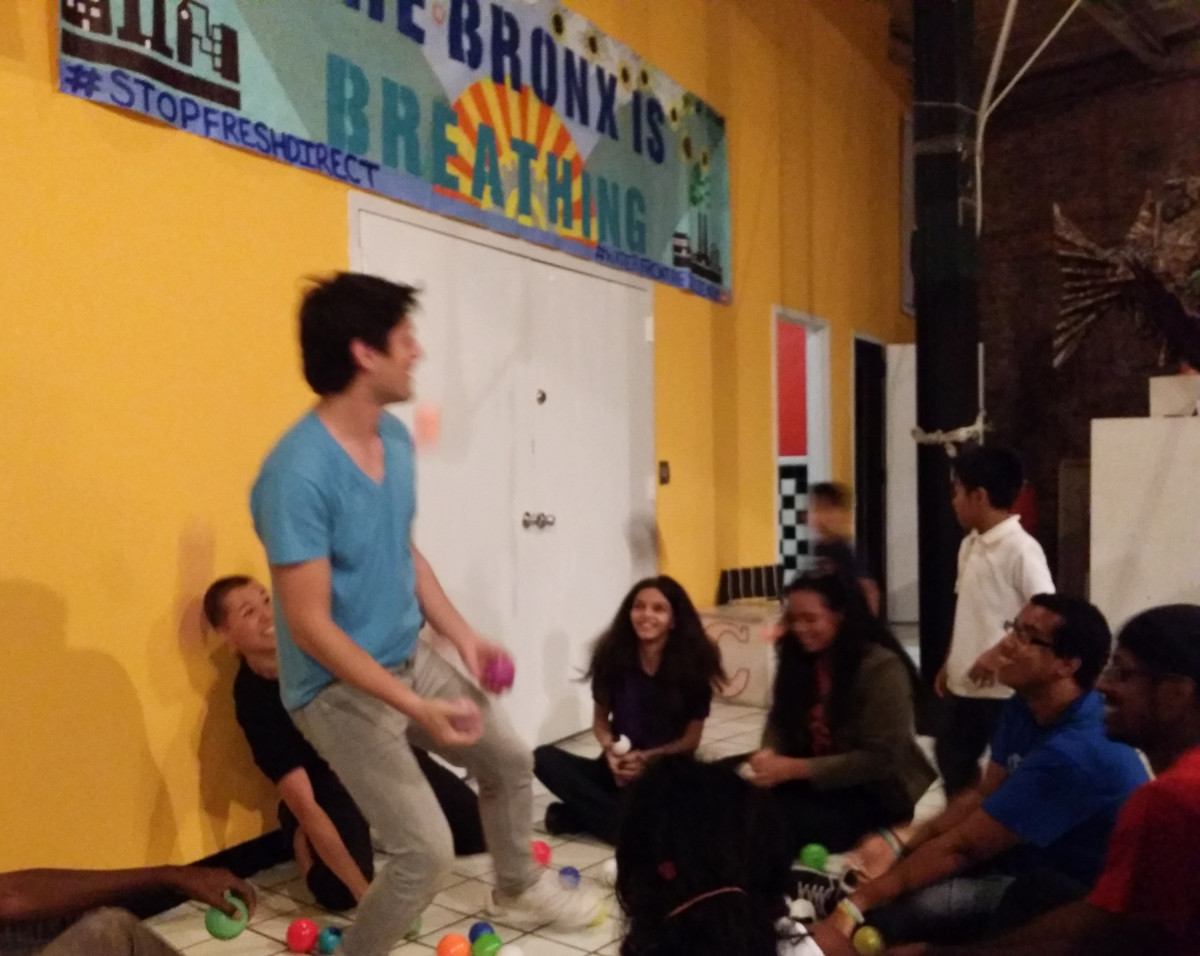
A group of jugglers sat in a circle to play the 100-ball juggle game. It was the first meeting of the year for the circus program at The Point (Saheli Roy Choudhury / THE BRONX INK)
Francis has learned over the years that the world of the circus has more to offer beyond a sweaty, social diversion. The circus industry has gone through many changes over the last two decades with the rise of contemporary circuses that compete with the traditional ones. Traditional circuses like the Big Apple Circus provide an intimate, artistic performance experience under the iconic circus tent. Ringling Brothers and Barnum & Bailey Circuses entertain with the razzle dazzle of three rings. Contemporary circuses like the world renowned Cirque du Soleil place emphasis on artistic performances, often supported by full orchestras.
The biggest change in the industry, according to Keith Nelson, founder of the vintage Bindlestiff Family Cirkus, is the decreasing number of traveling circuses around the country. Nelson believes the decline is related to the expense of traveling, with its higher insurance premiums as well as more paperwork. But there is reason to be optimistic, as a new vein of community-based circus performance is growing in popularity. It is creating new jobs in many non-profit groups that use circus performances as a means for education and social rehabilitation.
Francis started his foray into the circus by learning a little bit of everything. He learned tightrope walking along a thin, tensioned rope high above the ground. Francis found his favorite activity was mastering juggling with a variety of props like balls and clubs. He believes versatility is key to success in the circus. “If you’re in a circus and you only do one thing, “ said Francis, shaking his head a little, “you’re going to have a really hard time making money.”
The recent high school graduate has a lot of plans. He wants to study Information Technology at the Illinois State University because he likes “taking stuff apart and putting them back together.” But what he is hoping for is a spot with the university’s prestigious Gamma Phi Circus as a launching pad into the industry. The Gamma Phi Circus is the oldest collegiate circus in the country and its alumni have gone on to perform with many well-known circuses including Cirque du Soleil and the Roberts Brothers Circus.
For now, Francis focuses on practicing his skills to perfection. The teenager spends up to eight hours a day, most days after midnight, to practice his circus skills, particularly juggling. He said the improvements had been noticeable over the months, for which he had received high praise from Nelson and others, who see potential in him. He also teaches the juggling class at The Point to develop himself professionally. He’s part of the coaches-in-training program, geared toward teens who are serious about advancing their skills and also sharing the knowledge with peers. “I try to be as encouraging as I can,” said Francis about his teaching technique.
While the teens at The Point have aspiration in abundance, breaking into an industry as close-knit as the circus is an uphill task. Aside from stage performers, circus jobs can range from set designers to sound and light technicians to business managers. After the Soviet Union broke up in the early 1990s, there was a mass influx of talented Eastern European circus artists into the United States. This resulted in the growth of many multi-generation troupes in the country. “It’s a family business,” said Paul Miller, a professional clown by training and the founder of Circus Mojo, an organization in Kentucky that teaches circus skills and performance to adults and youths.
Miller has been in the industry for almost two decades and said the circus follows an “apprenticeship model” where seasoned performers have routinely refused to teach the skills to anyone outside their families. They believe the circus is their intellectual property, said Miller, and they protect it fiercely. Miller’s breakthrough came with the Ringling Brothers circus in 1996 when he won an apprenticeship as a clown. “I was a Gadjo,” he said, referring to the derogatory Romani term used to describe new circus performers who did not inherit the job from their ancestors. “Real artists would rarely have given me the time of day.”
For aspiring performers, there are more opportunities available now than there were during Miller’s time. More circus training schools have opened up in recent years, dedicated to training the next generation of gadjo performers. There are many non-profit organizations, funded by city councils and state funds, offering free or inexpensive courses in circus training; the knowledge that was once aggressively protected is becoming democratized.
Sixteen-year-old Xia Greenberg, from Queens, made the one and a half hour journey from Queens to attend the Hunts Point circus program last month. It was her first day as she stood in a corner and watched as others somersaulted through the air. “There are no circus classes in my neighborhood that are free,” said Greenberg, who had been riding the unicycle since she was 11. Her eyes were fixed on the solitary trapeze bar that hung in the right-hand corner of the auditorium. After some hesitation, the 5-foot-3-inch teenager gathered enough courage to climb the horizontal bar, holding tightly onto the ropes. Knees bent, she swung experimentally and smiled with satisfaction on her first attempt.
Greenberg fully intends to enter circus college after graduating from high school. She’s currently looking at the New England Center For Circus Arts in Vermont, which teaches many varieties of circus arts to its students. For Greenberg, the circus is a place where she can be herself. “I’m a really quiet person,” said the soft-spoken teenager, “so when I do circus, I feel like I can express myself without having to speak.”
Miller is very receptive towards younger performers as he knows the difficulties of breaking into the industry where having connections is essential. Earlier in July, he gave Francis, and his peer at the program 19-year-old Omar Rodriguez, a chance to perform in Cirque DeVou, a joint production between Circus Mojo and the Kentucky Symphony Orchestra, consisting of various circus acts like juggling and stilts walking, where the performer stands on small platforms elevated on a pair of poles. They performed before an audience of nearly 3,000. “My biggest crowd before that,” said Francis, smiling, “was 20 people.” Performing before a big crowd felt easier. “In a crowd of 20, if only 50 percent clap,” he said, “it’s not that much, but in a big crowd, it’s pretty loud.” It is a confidence booster.
The following month, Miller brought Francis to Germany with members of Circus Mojo on an international exchange program with a local circus, Circus Pimparello. “Germany’s a lot different from America,” said Francis, recalling the sense of wonder he felt on his first trip to Europe. “It was really fun and clean there. Not much trash cans but not a lot of trash either.” Francis immersed himself in classes in juggling and acrobatics and gave a series of street performances outside the Stuttgart Opera House, in Stuttgart, Germany. Though it was his first international street performance, he was not fazed. “People were just walking by and some stayed to watch,”he said, with a smile. “It was pretty fun.”
Francis believes juggling is the most difficult prop to master in the circus. He puts in four hours of practice every day. The improvements have been noticeable but there are “too many good jugglers out there.” He’s pragmatic about his chances of breaking into a professional circus, where having an extensive network makes a big difference. “I made a lot of connections this year,” he said beaming with confidence. “So I guess I’m off to a good start.”
Francis’ family back in Antigua, however, has set conditions for the young performer. “They’re pretty cool with it,” said Francis, as long as he gets a college degree first. They are not too thrilled with his recent spate of traveling for circus. Other parents have been more vocal in their disapproval of seeing their children run off to the circus. The stigma still exists, said Miller. “You know what they used say, lock your doors, lock your windows, the circus is in town!”
Within a big circus, there are a variety of non-performance jobs like house staff, ring crew who manage the day-to-day performances, the technical staff looking after lighting and sound, the kitchen staff, animal groomers, among others. The Cirque du Soleil, for example, is one of the biggest employers in the industry, hiring close to 4,000 employees, of which only 1,300 are artists.
New avenues for circus acts have also been on the rise with places like cruise ships, theme parks, nightclubs, shopping malls and casinos hiring skilled performers. The rise of social circus–where circus is used as a tool for social intervention and rehabilitation among high risk groups–has added to the demand for performers; for example, the Big Apple Circus’ Clown Care program is an outreach effort where clowns perform in pediatric facilities across the country.
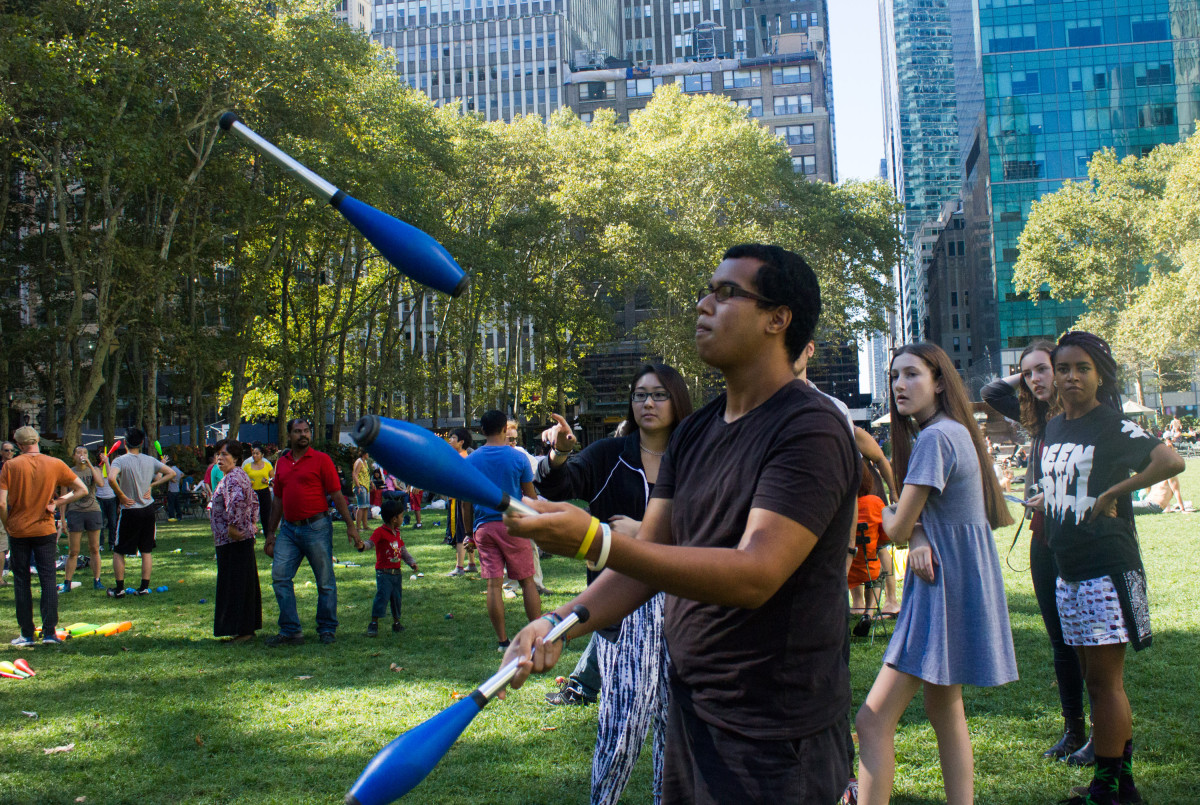
Omar Rodriguez, 19, is a regular at The Point’s circus program. Along with Jean-Tae Francis, Omar can frequently be seen juggling at Bryant Park on Saturday afternoons. (Saheli Roy Choudhury / THE BRONX INK)
Rookies work long hours, do grueling tasks, and get very little pay. But Miller reckons starting small and climbing up the ladder is the traditional way to go. When he started his clown apprenticeship with the Ringling Brothers, he worked 60 hours a week and earned $237; which amounted to $4 an hour, slightly below the minimum wage rate of $5.15 in 1997. Miller defended the “exploitative” nature of the circus towards newcomers and said rewards for perseverance are high. Following his apprenticeship, Miller went on to work as a circus performer in casinos around the country, making $500 a day; more recently, he worked for six months in Japan, putting in “12 minutes a day” worth of effort, and was paid $2,000.
For athletic performers, the lifespan is relatively short. By 40, most of them are “old, broken circus performers” reduced to manning the concession stands, said Miller. With many big circuses like Cirque du Soleil opting to hire Olympic athletes and professionally trained dancers, many young, talented circus performers are also going out of work. Jugglers have a longer lifespan, which makes it more competitive – a fact Francis said motivates him to work harder. “I met a lot of really good jugglers this year,” he said, which made him focus more on developing his technique and skills.
The road has been bumpy for Francis. Two years ago, he had his first opportunity to go on an overseas trip to Italy to perform with a circus troupe. “While the trip was upcoming, I didn’t have my U.S. passport at that time, so I wasn’t able to go,” said Francis. Disheartened and frustrated, Francis wanted nothing to do with the circus anymore. For the next three months, he hung out with his friends on the basketball court. Eventually, he could no longer ignore the call of the stage and returned to the circus program. Francis still thinks about giving up circus when going through a bad patch. “But I never actually go through with it,” said Francis, with a smile.
One of the most important persons Francis turns to, whenever he experiences his moments of self-doubt, is the circus program coordinator at The Point. With short hair, a pair of t-shirt and three-quarters, and a warm, welcoming smile, Amy Chen easily stands out in the crowd. The coordinator herself is a trained juggler, trapeze artist, and acrobat, and occasionally performs one of the toughest circus acts–fire breathing.
When she started working at the teen program, her goal was to promote the ideas of community building and peer support, along with teaching the teens about circus. “Most of the students came in their cliques of friends and were primarily interested in furthering their individual skills,” said Chen. The tumblers had no interest in juggling while the jugglers did not care much about aerials. Everyone wanted to focus on their own interests and on ways to further them. The sense of collaboration and togetherness took time to build and nurture. Chen keeps careful track of each and every student who drops by the program and works to build a tight-knit circus family. “They have each other’s backs–so no matter what they choose to do with their circus skills in the future, they have each other,” she said.
Back at The Point, when practice time was over, most of the teens stayed back and continued with their juggling and tumbling routines even as the night grew darker. Francis was one of the last to leave. Though the dedication of the students and the instructors were evident, the program has yet to place a graduate with a professional circus. The overwhelming odds do not deter Francis about his future. For now, he wants to simply focus on perfecting his techniques. “It makes me happy to juggle,” he said. “It makes me happy to make other people happy when I’m doing it well.”








